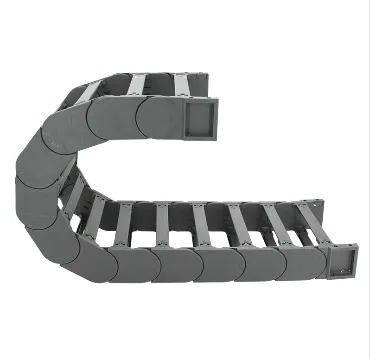Cable Drag Chain: An Essential Guide to Selection, Pricing & Manufacturers
In today’s fast-moving automation and industrial sectors, ensuring the safety and performance of cable and hose systems is paramount. One of the most effective ways to protect and guide these systems is through a cable drag chain—a mechanical component that organizes, protects, and supports cables and hoses in motion. Whether you’re automating machinery or managing a complex robotic arm, drag chains are indispensable.

This article will walk you through everything you need to know about cable drag chains, choosing the right drag chain manufacturer, understanding cable drag chain price factors, and how to use a cable drag chain catalogue to make informed decisions.
What is a Cable Drag Chain?
A cable drag chain, also known as an energy chain or cable carrier, is a flexible, yet robust mechanical structure designed to house and guide cables, hydraulic hoses, or pneumatic tubes. It ensures that these elements move smoothly along a linear or circular path without tangling, twisting, or wearing prematurely.
Cable drag chains are typically made from:
Reinforced plastic (lightweight, corrosion-resistant)
Steel or stainless steel (heavy-duty, high-temperature)
Hybrid materials (custom applications)
These chains are commonly used in:
CNC machinery
Robotics
Automated production lines
Material handling systems
Medical and laboratory equipment
How Does a Cable Drag Chain Work?
Cable drag chains consist of interconnected links that bend in one direction, forming a flexible guide path. The inner chamber holds the cables or hoses, protecting them from mechanical stress and environmental damage. As the machine moves, the drag chain moves with it, maintaining a consistent bending radius and preventing cable wear or entanglement.
Key features include:
Noise reduction
Extended cable/hose life
High-speed motion capability
Easy installation and replacement
Choosing the Right Drag Chain Manufacturer
When sourcing drag chains, selecting a reliable drag chain manufacturer can directly impact performance, durability, and long-term costs. Top manufacturers not only produce high-quality drag chains but also provide technical guidance, custom options, and ongoing support.
What to Look for in a Manufacturer:
Material Variety: Offers chains in plastic, steel, or hybrid formats
Custom Solutions: Ability to tailor width, height, or mounting configurations
Proven Track Record: Years of experience and successful project implementations
Compliance & Certification: Meets relevant industry standards (e.g., ISO, RoHS)
Technical Support: Offers CAD drawings, simulations, or test samples
Fast Turnaround: Responsive production and delivery timelines
Leading drag chain manufacturers often publish detailed cable drag chain catalogues that include dimensions, performance specs, installation instructions, and selection guides.
Understanding Cable Drag Chain Price
The cable drag chain price can vary significantly depending on the type, material, and size of the product. Knowing what impacts pricing will help you budget more effectively and avoid overpaying.
Price Influencers:
Material Type
Plastic drag chains: $5 – $30 per meter
Steel drag chains: $20 – $100+ per meter
Chain Size
Larger chains with higher load capacities cost more.
Micro drag chains (for printers or compact robotics) are cheaper.
Length and Quantity
Bulk purchases or longer chain orders often come with volume discounts.
Customization
Unique configurations, integrated separators, or pre-assembled cable sets can add cost.
Supplier Location
Domestic manufacturers may charge more than overseas suppliers, but offer faster shipping and better support.
Before buying, always request a detailed quote based on your exact specifications and compare it across several drag chain manufacturers.
How to Use a Cable Drag Chain Catalogue
A cable drag chain catalogue is an invaluable tool for engineers and purchasing managers. It helps you compare various chain models and identify the best fit based on application requirements.
What You'll Typically Find:
Product Descriptions: Material, design, motion capabilities
Dimensions: Inner/outer height, width, bending radius
Load Capacity: Maximum cable weight, speed, and acceleration tolerance
Mounting Options: Fixed or movable ends, brackets, horizontal or vertical installation
Accessories: Strain reliefs, separators, covers
Digital catalogues often include 3D CAD files, selection wizards, or downloadable spec sheets. These help streamline the design and procurement process.
Benefits of Using a Cable Drag Chain
Improved Cable Life: Reduces wear and fatigue on cables and hoses.
Better Organization: Keeps cables aligned and manageable, reducing clutter.
Enhanced Machine Performance: Prevents drag or pull on moving parts.
Safety: Reduces risk of electrical shorts, hydraulic leaks, or accidental snagging.
Cost Savings: Reduces cable failure, downtime, and replacement costs.
Common Applications
Cable drag chains are used in a wide range of industries and equipment:
Manufacturing: CNC mills, lathes, plasma cutters
Automotive: Assembly lines, robotic welding systems
Medical Devices: Imaging equipment, automated lab systems
Logistics: Conveyor belts, automated storage retrieval systems
Renewable Energy: Wind turbines, solar tracking systems
No matter the industry, a well-designed drag chain solution ensures reliability and ease of maintenance.
Cable Drag Chain FAQs
Q1: How do I determine the right size for a cable drag chain?
A: Calculate the total outer diameter of all cables and hoses, then add spacing (typically 10–20%). Use this to choose a chain with appropriate internal height and width.
Q2: Can I use drag chains outdoors?
A: Yes, but choose UV- and weather-resistant materials like stainless steel or specialized plastics.
Q3: How long do cable drag chains last?
A: With proper selection and installation, drag chains can last over 10 million cycles. However, lifespan depends on speed, environment, and load.
Q4: Are there drag chains for vertical motion?
A: Yes. Many manufacturers offer drag chains designed for vertical or combined multi-directional motion.
Q5: Where can I get a cable drag chain catalogue?
A: Most manufacturers offer downloadable PDF catalogues on their websites. You can also request printed versions or interactive design tools.
A cable drag chain is a critical yet often overlooked component in modern machinery. Whether you're designing an automated production system or maintaining existing equipment, selecting the right drag chain ensures smooth operation, protects your cabling system, and reduces maintenance costs.
By partnering with a reliable drag chain manufacturer, understanding cable drag chain price factors, and leveraging a comprehensive cable drag chain catalogue, you can make informed choices that support long-term performance and efficiency.








